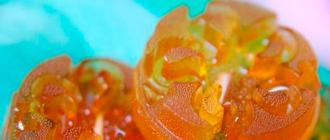Hello everyone, in this instruction we will look at the technique of making an interesting tactical knife from wrenches. In fact, tool steel is the best suited for making knives; it is durable due to high content carbon and can be easily hardened. If you suddenly break a key, do not forget that it is high-quality steel and something can be made from it.
The knife is made without the use of a forge; all you need to have for heat treatment is a gas burner, or preferably two. The author uses them not for hardening, but for tempering metal and removing internal tension, so you don’t need to heat the metal too much.
Since steel is processed without tempering, it will not be possible to sharpen such a knife by hand; here you will need. The knife made is so sharp that the author shaves hair with it without any problems, and it is so strong that it can be used to chop branches.
Materials and tools used
List of materials:
- wrench ¾;
- cap part of the key;
- two screws with internal nuts (like pins);
- handle lining (wood, textolite, etc. are suitable).
List of tools:
-
- files for metal and wood;
- Bulgarian;
- gas burner;
- drilling machine or drill;
- marker;
- jigsaw;
- a machine or grinder with a wire brush;
- pliers, screwdrivers and other small items.
Knife making process:
Step one. Local metal tempering
To steel wrench could be processed hand tools, you need to let her go first. To do this, the author heats the steel with a gas burner and, tapping with a hammer, allows it to gradually cool. It is advisable to repeat the procedure several times. If the hammer begins to leave a mark on the metal, it means that the steel has been tempered and can be processed.



Step two. Groove for handle
The knife has two handles, so to speak, one main and the other for the finger. Thanks to this design, you can perform various tricks with the knife, and it also holds well in the hand. We take a file and grind out a groove; the other part from the wrench should fit here. The groove can be easily sharpened using files, because we have released the metal and it has become soft. Match the parts perfectly to each other.









Step three. Drilling mounting holes
In the tail part of the hole you need to drill two holes; they are intended for installing pins, which are bolts with nuts. You won’t be able to drill them with a regular drill without releasing the metal; here you will need a drill with a special tip. Well, or, you can still loosen the metal locally and drill them with a regular drill.

Step four. Let's start sanding
Now we need such a powerful tool as . Let's start sanding, first sand the workpiece along the contour to get the desired shape.




Next, we proceed to forming the bevels. Judging by the video, the author makes them by eye, without marking anything on the blade. If the tape on your machine is narrow, then make the bevels sequentially. When making bevels or sharpening a blade, always hold the blade upward, towards the moving belt. Remember that the metal cannot be overheated, as it will temper. Cool the workpiece in water from time to time.







Step five. Handle covers
Let's start finishing the handle, here you will need textolite, wood, you can also use animal horns and other materials. Plus in favor artificial materials is that they, as a rule, do not need additional finishing. For example, wood must be impregnated with oil so that it does not absorb moisture.







We apply the tail part to the material and outline it with a marker. You will need two pads in total. Cut them out using a jigsaw and then drill two holes for the pins. Screws with union (internal) nuts are used as pins.
Now screw the covers together using screws and nuts. Thanks to the one-piece design, you can make both parts absolutely identical. And again we go to the belt sanding machine, we process the profile of the product along the contour to level it. In principle, other types of work are not necessary.
Step six. Knife assembly
We take the pads and unscrew them, then install them on the knife. The author does not use glue for installation, so you will have the opportunity to replace the pads if they break. The most important thing is to tighten the nuts well. First we tighten it with a screwdriver, then you can finally tighten it manually. But keep in mind that if you tighten too much, the material of the pads may crack.









Having assembled the knife, we again go to the belt sander. Now we need to form the final profile of the handle. The metal should be flush with the handle. Grind off the sharp edges and form a comfortable handle profile to your liking.


Finally, the author proceeds to manual processing of the pen. For this task you will need sandpaper. We make the handle absolutely smooth, gradually reducing the grain size of the sandpaper. For the sandpaper to work well, moisten it with water, so it cleans itself.
Step seven. Temperature treatment
Before this step, the covers must be removed by unscrewing the screws and nuts.
The author warms up the blade using two burners. This process is called tempering the metal, which makes it more elastic and also relieves internal stress. However, this step is not necessary, since when making wrenches, the metal is already hardened to optimal hardness. You can visually determine whether it has warmed up to the desired temperature by color; the metal should become straw-colored.



Step eight. Blade cleaning
After heat treatment, the metal will change color; this problem must be solved. A machine with a wire brush will come to the rescue. We clean the metal until it shines.



Step nine. Sharpening and polishing
Fit the belt sander with a fine-grit belt and rough sharpen the knife. Hold the blade towards the movement of the belt. Then a polishing belt is installed on the machine. It can be used to polish a knife to a shine and sharpen the blade to a razor-sharp state.
Greetings to fans of burning metal. This time we will look at how to make a simple and interesting knife from a wrench. The good thing about this homemade product is that almost everyone has a wrench, and you can also use your old broken wrench for these purposes. Wrenches can be made from a variety of alloys, most of which are vanadium alloys. Such alloys are not very suitable for making knives, since the metal is ductile and when sharpened the blade will not hold its edge for long. However, many people even like it, because the knife can be sharpened quickly. And the frequency of sharpening depends on what you plan to cut.
It’s not difficult to make such a knife, we won’t forge anything here, the only thing we’ll make out of something complex is hardening. However, this procedure is questionable, since in most cases we will not know how to harden such steel. Overall, everything turned out interesting and original. Let's take a closer look at how to make such a knife!
Materials and tools used
List of materials:
- 30mm wrench or similar;
- a piece of board (for overlays);
- brass rods (for pins);
- epoxy glue;
- oil for impregnating wood.
List of tools:
- Bulgarian;
- belt grinder;
- marker;
- vice;
- clamps;
- forge furnace;
- drill;
- drilling machine;
- sandpaper.
Knife making process:
Step one. Cutting out the main profile
First, we clean the key from rust so that you can draw on it. It is convenient to do this with a grinder with a wire attachment or sandpaper by hand. Next, take a marker and draw the desired blade profile. Well, then we start cutting. We clamp the key in a vice and cut off the excess with a grinder. The author also cut off the excess parts in the nose of the blade, so as not to sand the excess later.
Finally, we go over the contour with a sanding disc or process the contour on a belt sander, as the author does.









Step two. Forming the blade
Next, we need to shape the part of the knife that will be the blade. Take a marker and make the necessary marks. Next, we clamp the blade in a special holder and begin grinding. We need to sand off all excess and form the desired thickness of the blade. As a result, we get an excellent blade.




Step three. Making bevels
Again, take a marker and draw the width of the bevels; the author has them at the maximum width. This will allow the knife to cut well, as the blade will be thin. We also take a caliper and draw a center line along the blade. We will focus on it when forming bevels. A little work on the belt sander and the bevels are ready. If there are deep scratches on the metal, sand them manually using sandpaper, as further hardening will take place and the metal will be processed worse.




Step four. Tempering the blade
The author decided to harden his blade, but the problem is that it is not known what grade of steel was used, because all steels are hardened in different conditions. However, you can try to harden the blade, but it is better to experiment with a separate piece of metal. The author heats the blade to a yellowish glow, and then cools it in oil. The tempering procedure was not performed, so it remains unknown whether the blade will be brittle after this. After hardening, the metal can be scratched with a file; if the scratches remain, it means the hardening was unsuccessful.



Step five. Clean the knife and drill holes
After hardening, there will be traces of oxidation on the metal, we need to remove them. To do this, we work with sandpaper, wetting it in water. Water allows the paper to be cleaned effectively and it works better. Of course, the sandpaper for this should be fabric-based.










Next you can drill holes. This can be quite problematic, we use a drilling machine with good drill bits. The holes should be of such a diameter that the pins fit into them as tightly as possible. This will ensure a good grip on the handle.
Step six. Making pads and assembling the knife
The author makes the overlays from wood. Place the handle on the board and drill holes for the pins. Well, then we cut out two overlays and process them on a belt sander. The author brings the linings to a finished state, that is, we will no longer grind the handle together with the knife.









That's all, the pads can be installed on the knife. Here we need pins and epoxy glue. We carefully clean all surfaces to be glued so that the glue sticks well. We apply epoxy glue, install the pins and tighten everything with clamps until the glue hardens. When the glue has dried, carefully cut off the pins and lightly sand the pads to level the pins with the plane.
Next, the wood must be impregnated with oil to protect it from moisture and dirt. It is also recommended to coat the metal with oil so that it does not rust during storage. In general, wrenches rust quite badly, not counting modern shiny wrenches, which are well protected from this. That's all, the knife is ready, all that remains is to sharpen it!
That's it, the project is over. Good luck and creative inspiration if you want to repeat it. Don't forget to share your homemade products and experiences with us!
In the kitchen, having a knife sharpener is a must. Many people use whetstones or similar abrasives. However, such tools require more labor-intensive work and maintaining an optimal inclination during the sharpening process; you need to correctly hold the blade in relation to the surface of the sharpening stone and make quite a lot of movements with pressure.
Modern sharpener options
In addition, there are more effective, but much more expensive sharpening options. For example, there are special abrasives that are sold in the form of grains that fill one or another container (most often a glass or decanter) and the knife is sharpened when placed/dipped into such a container. Interesting option, but such purchases are quite expensive.
It is possible to buy Chinese sharpeners, which consist of abrasive wheels attached to the handle. Same good option, inexpensive and convenient, no need to tilt, the only problem is that the quality and service life of such a device are extremely low. Simply put, the purchase will not last long and then you will need to purchase a new sharpener, albeit not an expensive one.
Is it possible to find something optimal in this diversity? As you know, if you want something, you need to do it yourself. This is exactly the case with a knife sharpener. It is possible to take the design of Chinese sharpeners, but use more durable parts and make your own inexpensive but high-quality option.
Sharpeners and wrenches
In order to make the device we are considering, you will need to use a ring wrench. This will be optimal.
Please note. In fact, a ring jaw is only the most convenient option, but it is also possible to take just a wrench, but perhaps it will be a little more work.
The work will require:
- Bulgarian;
- welding machine;
- rubber gaskets;
- a pair of abrasive wheels;
- washers and hex nuts;
- small twig with thread.
The creation process is simple and elementary, so we won’t go into details, if something is not entirely clear, just start doing it and the details will become clearer in the process.
It’s really quite easy to understand both the design and how to do the work, here are the main steps:
- make a small cut at the end of the throat, a centimeter and a half;
- We weld nuts to the ends;
- we clean, trim the welding;
- we insert a threaded rod into the nuts, which we then also tighten with nuts on both sides;
- however, first we put in the center: washer, abrasive wheel, washer, spacer, washer, circle, washer;
- Tighten the structure tightly with nuts from the outside.
All that remains is to make a comfortable handle. For this they can be used various options. For example, twist the handle with plastic or other material, you can even turn a wooden handle.
Anyway, this is the end of the sharpener. Turning is done by placing the knife between the inner washer and the abrasive wheel and working it there. It is clear that you will need to sharpen each side evenly.

Do you want to start making knives, but don’t know where to get them? good steel for this matter? It's right under your nose - these are wrenches. They use high-quality high-carbon steel, which lends itself well to hardening, forging, and so on. Of course, the wrench should be branded, and not made of raw Chinese steel. As a rule, when processing good metal with a grinder, abundant sparks fly.
Wrenches are not expensive; a manufactured knife will cost tens of times more than a wrench, even if it was just bought in a store.
The method of making a knife, which we will consider today, is a rather professional approach - forging. But there is no need to be scared and run away; when making the knife, the author used very simple, common tools that anyone can probably get. As for the stove, it can be made from a bucket, and grill coals act as fuel.
Materials and tools that the author used to make the knife:
List of materials:
- a wrench (you can choose the size at your discretion);
- two nails (used as pins);
- wood (for handle lining);
- epoxy glue;
- oil for impregnating wood.
List of tools:
- clamps;
- gas burner (preferably);
- Dremel or drill with a sanding attachment;
- polishing attachment for drill;
-
- sharpener;
- files;
- vice;
- sandpaper of different grain sizes;
- hammer;
- anvil;
-
- oil (for hardening);
- pliers;
- bucket stove (or similar);
- coal;
- household hair dryer + piece of pipe;
- lighter fluid.


Knife making process:
Step one. Preparing the workpiece
We take a wrench, which we don’t mind sacrificing, and the open-end part from it. The key does not have to be good; you can use a broken, broken one, and so on.


Step two. Leveling the workpiece
Light your stove; the coals can be fanned using a regular hairdryer. We heat the workpiece red-hot, after which the metal will become soft. We clamp the workpiece in a vice and align the cap part, since it is made at an angle. All this is done with light blows of the hammer.






Step three. Let's start forging
We heat up that part of the workpiece that will act as a blade. We work with a hammer on an anvil. The metal cools down quite quickly, so the workpiece will have to be heated more than once, exactly how much depends on the skill. Form the desired blade profile and level it.





Step four. Forming rough grinding
We have formed the main profile, now we clamp the workpiece in a vice and go over the blade with a grinder, with a grinding wheel installed. You can grind the profile along the contour and also form bevels. When forging, you should try to make the blade as thin as possible, so that later there will be less grinding work.



Step five. Hardening
Before hardening the knife, the author decided to slightly flatten the cap part of the key so that it would not interfere with holding the knife. But this is not at all necessary; you can leave it as is. We heat this part red-hot and then squeeze it in a vice.


Let's move on to hardening; it is important to note that this process also involves the use of metal tempering, but for some reason the author missed this point. To harden, heat the knife until red hot and cool it in oil; you can use vegetable or mineral oil. Judging by the color, the author uses automotive work.

Next, it is recommended to temper the metal, since it will be brittle and at some point may break. Place the blade in the oven and heat for about an hour at a temperature of 200-250 degrees Celsius, then let it cool in the oven without opening it.

Step six. Drill holes and assemble the handle
First of all, you need to drill two holes for the pins in the tail section. The author decided to use ordinary nails as pins. It is not aesthetically pleasing, but it is reliable and practical. You can’t just drill holes in hardened metal; to do this you will need to release it. We take a torch and heat the metal in in the right place until red-hot, then let it cool smoothly. That's it, the steel has become soft, holes can be drilled with a regular metal drill.










You can start assembling the handle; here you will need plywood, thin boards or other similar material. If you wish, you can make a typesetting pen. We take the blanks and drill holes in them for the pins, and assemble all the parts on the nails. To glue the components together you will need epoxy glue. At the end, we will tighten the whole thing with clamps and let the glue dry completely. It takes 24 hours for the epoxy glue to dry completely.
Step seven. Let's finish the handle
Let's start processing the handle; for rough work we use a sharpener or rasp. To treat problem areas, use a Dremel or a drill with a sanding attachment. We form the main profile of the handle depending on the needs.










Now comes the stage of finer wood processing. Sandpaper will help us with this. First we use large paper, then smaller and smaller. Making the handle absolutely smooth.
Step eight. Sharpening a knife
To sharpen the knife, the author uses a special sharpening tool.






